What Does Navy Do With Retired Blue Angles Jets
The Blue Angels are one of the oldest aerobatic flight teams in the world, performing flight demonstrations for fans throughout most of the year. While most people recognize the distinct navy blue and yellow Hornets flown by the Blue Angels, they may not know much else about these experienced pilots.
So, why do thousands of people show up to see the Blue Angels perform? For many of us, watching the Blue Angels stirs emotions of patriotism and pride in our military. The Blue Angels were formed in 1946 and continue to amaze audiences at flight shows. The team is comprised of volunteers who have served in the US Navy or Marine Corps. They demonstrate the commitment of men and women to the field of aviation by performing aerobatic formations in fighter jets.
With over seven decades of history, there are a lot of interesting facts to uncover about the Blue Angels, including where they started and how they manage to fly close together.
What Are the Blue Angels?
The Blue Angels is a team of experienced fighter pilots from the US Navy and Marine Corps. They perform aerial displays at public exhibitions throughout most of the year. The Blue Angels were formed in 1946, a couple of years after the end of World War II. The pilots and jets sport navy blue and yellow coloring.
The Blue Angels have a specific mission. They are intended to showcase the pride and professionalism of the US Navy and Marine Corps by promoting a culture of excellence and service to the country. They hope to achieve this mission through a combination of flight demonstrations and community outreach.
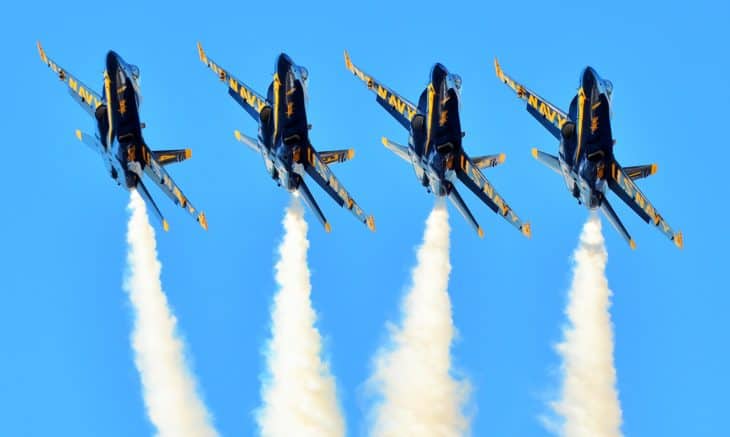
About 11 million spectators watch the Blue Angels fly at 60 airshows at 30 locations from March to December. The airshows may also include demonstrations from other flight teams, including teams that perform death-defying aerobatic stunts such as loops.
When WWII ended, many pilots wanted to continue demonstrating the flight skills that they had developed. They also wanted to increase public interest in naval aviation. This led US Navy Fleet Admiral Chester Nimitz to create a flight exhibition team.
The team was originally called the "Navy Flight Demonstration Squadron." A local newspaper near the naval station in Florida ran a contest asking citizens to name the team. Suggestions included Death-Cheaters, The Sea Eagles, The Skyscrapers, and The Flying Buccaneers. However, the team disliked the suggestions. A member of the team saw a listing for the Blue Angel Nightclub in New York City in an issue of the New Yorker. A few days later, the team introduced themselves as the Blue Angels.
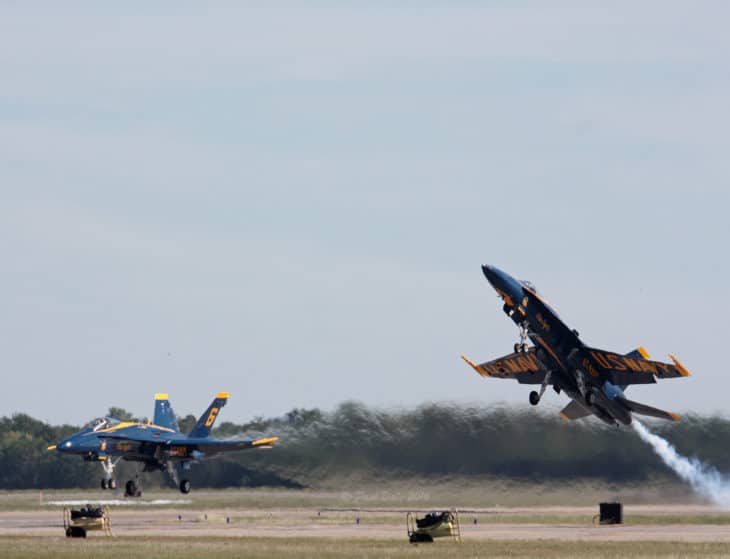
Where Are the Blue Angels Based?
The Blue Angels are stationed at US Naval Air Bases. From January to March, the Blue Angels team trains at the Naval Air Facility in El Centro, California. The Blue Angels are then stationed at the Forrest Sherman Field at the Naval Air Station in Pensacola, Florida for the airshow season.
However, they travel around the country and even visit other countries to put on flight demonstrations. The Blue Angels also visit hospitals, schools, and community centers. As ambassadors of goodwill, they interact with the public and inspire young aviation enthusiasts.
How Fast Do the Blue Angels Fly?
The Blue Angels travel at speeds between 120 mph and 700 mph. However, not all the jets in the team fly at the fastest speeds. During a typical performance, there are six jets in the air. The first four jets fly in a diamond formation. The fifth and sixth jet fly in solo formation.

The diamond formation flies at lower speeds, allowing them to form closer formations and perform various maneuvers that would be impossible at faster speeds. The jets in the diamond formation travel at an average of about 400 mph. The solo jets fly faster to demonstrate the capabilities of the aircraft. They perform high-speed passes, fast rolls, and tight turns.
Along with varying speeds, the Blue Angels fly at varying heights. The altitude of the performance depends on the weather conditions. When the weather is clear, the team flies at least 8000 feet above the ground. When the skies are overcast, the team maintains an altitude of at least 3500 feet. The minimum altitude is lowered to 1500 feet when flying in limited visibility conditions.
How Many Blue Angels Are There?
There are 16 Blue Angels on the flight team at any given time. However, the team also has various support officers including a flight surgeon, events coordinator, maintenance officer, public affairs officer, and supply officer.
The Blue Angels team currently includes a total of 130 active-duty Marines and sailors. Most of the team members have ranks from E-4 to E-9. After completing their assignment with the Blue Angels squadron, team members return to their fleets. Every member of the team is a volunteer from the US Navy or Marine Corps. Applicants must undergo a thorough screening process, including an interview.

When Do the Blue Angels Practice?
The Blue Angels practice at the Naval Air Facility in El Centro, California from January to March. During the winter training, the pilots fly two practice flights each day for six days out of the week. At the start of winter training, the Blue Angels fly in formations at higher altitudes and with greater distance between each jet. As the training progresses, they fly closer together and at lower altitudes.
The pilots need to complete 120 training missions before they start public demonstrations during the airshow season in the spring. However, the Blue Angels continue to practice throughout the year. After the Blue Angels return to their home base in Pensacola, they continue to fly practice missions on Tuesdays and Wednesdays.
What Planes Do the Blue Angels Fly?

The Blue Angels currently fly six McDonnell Douglas F/A-18 Hornets. The team previously used a USMC Lockheed C-130T Hercules to carry spare parts and perform Jet Assisted Take-Off (JATO) demonstrations. The C-130T was nicknamed the "Fat Albert" but was removed from service in 2009. It was replaced by the BUNO 164763 aircraft, which was retired in 2019. The Blue Angels plan on adding an Ex-RAF C-130J to fill the place of the Fat Albert.
When the Blue Angels formed in 1946, they flew the Grumman F6F-5 Hellcat. After the Korean War, the team flew F9F-6 Panthers, which were followed by the F9F-8 Cougar and the Grumman F11F-1 Tiger and the Douglas A-4 Skyhawk.
The Hornets were introduced in 1986 on the 40th anniversary of the Blue Angels formation. The six F/A-18 Hornets are used for flight performances. However, the team also has a modified two-seat F/A-18D Hornet for VIP passengers.
-

Blue Angels F6F Hellcat and F8F Bearcat Heritage flight -
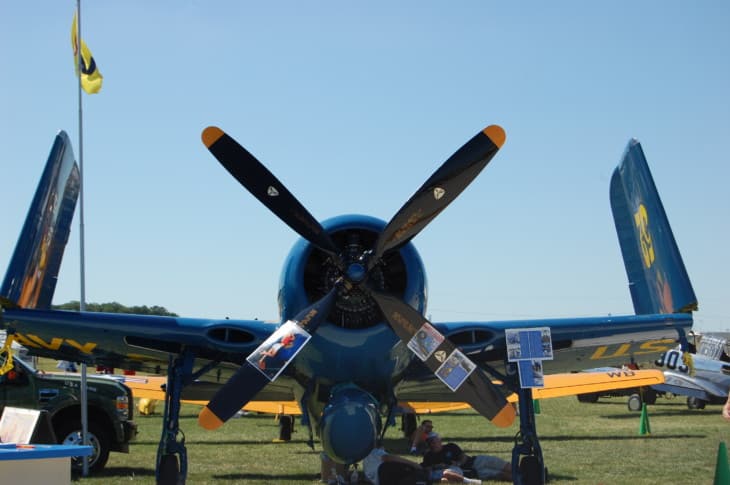
A blue angels Grumman F8F Bearcat -

Grumman F9F-2 Panther of the Blue Angels -

Grumman F9F-2 Panthers of the Blue Angels -
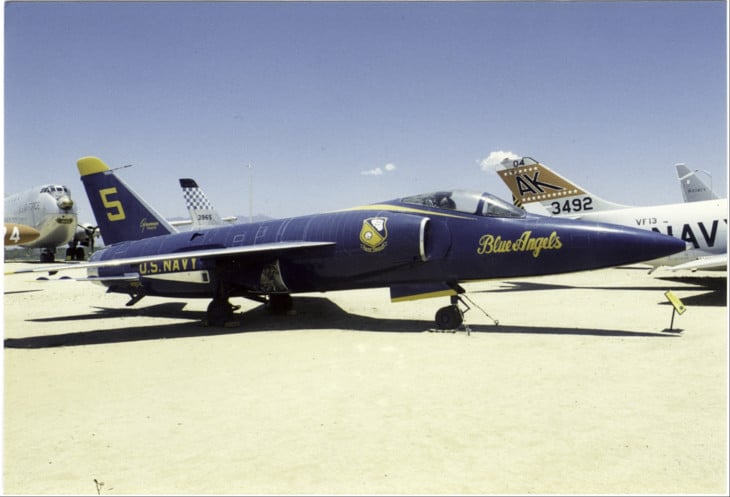
Grumman F11F-1 Tiger (Bu.No . 141824) Blue Angels No. 5 -
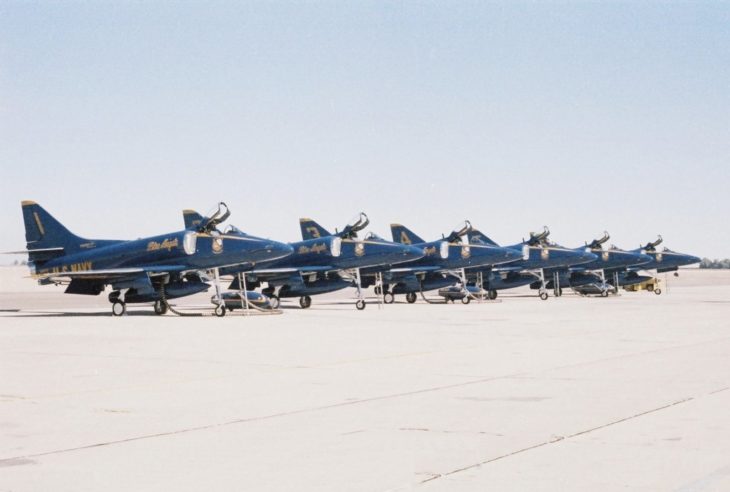
Blue Angels Douglas A-4F Skyhawk -
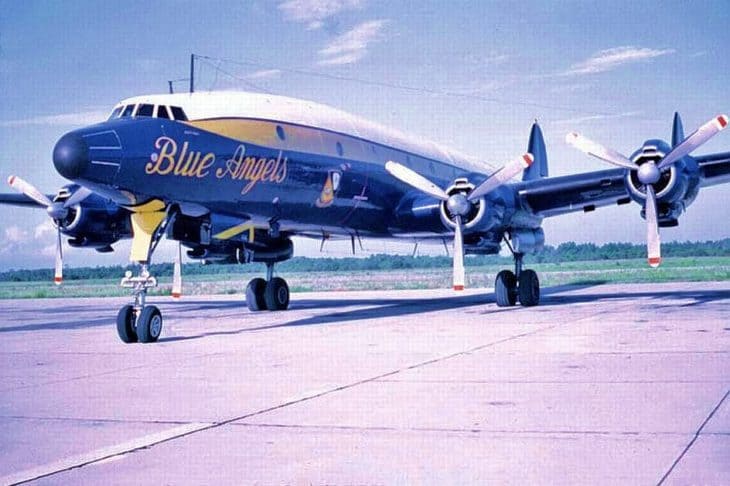
Lockheed Constellation of the Blue Angels 1 -

Lockheed Constellation of the Blue Angels -
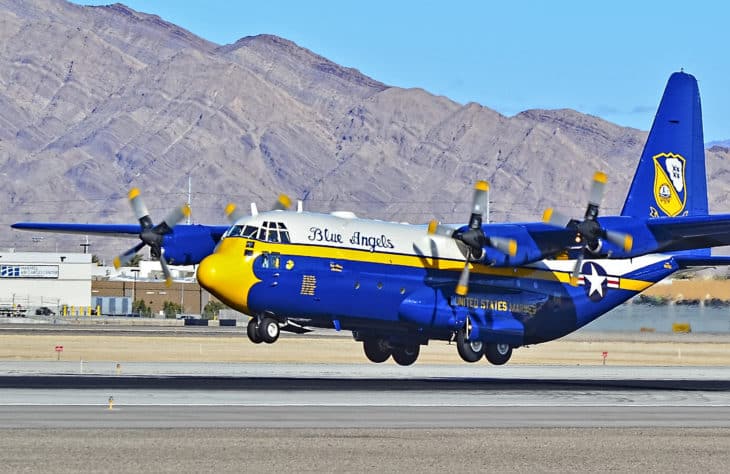
Blue Angels Fat Albert 1992 Lockheed C-130T Hercules
How Many Blue Angels Have Died?
27 Blue Angels pilots have died during airshow accidents or training accidents since the formation of the team. From 1946 to 2019, the Blue Angels team has included 267 demonstration pilots and 37 flight officers.
Pilots who fly with the Blue Angels have a fatality rate of about 8.8%, which is significantly higher compared to commercial pilots. There are about 40 deaths per 100,000 commercial pilots. The first death of a Blue Angels pilot occurred during the first year of public demonstrations. Lt. Ross Robinson was killed when a wingtip broke off his plane, sending the pilot into an uncontrollable spin.
A mid-air collision occurred during a performance in 1952. One pilot died and the other survived. The most recent death occurred in 2016 during a practice run for an airshow in Smyrna, Tennessee. Captain Jeff Kuss was performing the Split-S maneuver just after takeoff when he crashed. Investigators found that he was flying at too low of an altitude to pull off the maneuver.
How to Fly with the Blue Angels
The Blue Angels have three seats available for civilians during each airshow. One seat is given to a member of the press while the other two are reserved for VIP guests. The two reserved seats are for members of the Key Influencer (KI) program. The program was created to increase the outreach efforts of the Blue Angels. To qualify for the KI program, an individual must be actively involved in helping youths in their community.
Individuals are nominated by the members of the Navy or Marine Corps in their local area. This requires individuals to actively participate in programs that involve the US Navy or Marines.
The bottom line is that you cannot pay to fly with the Blue Angels. You need to make a difference in your community and be nominated. The only alternative is to fly with the Blue Angels as a member of the press. At each airshow, the Blue Angels select one credentialed media representative to fly in one of the three available seats.
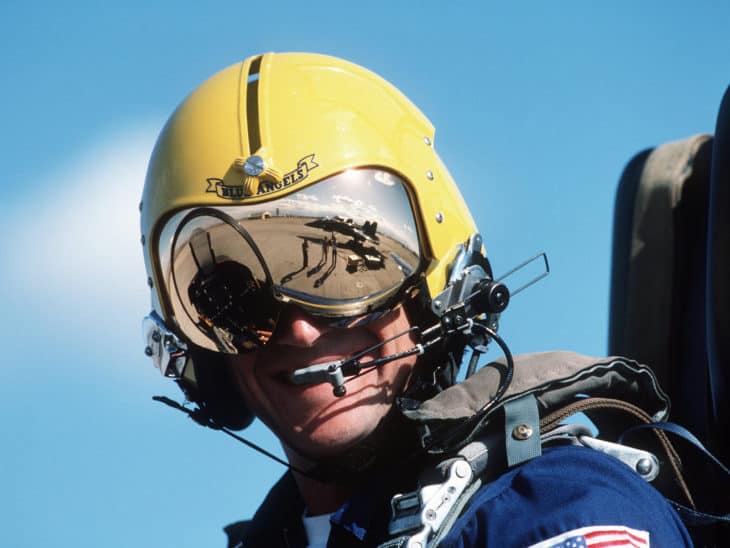
Where Do You Watch the Blue Angels?
The Blue Angels perform about 60 airshows each year, traveling to 30 different locations in the United States and two locations in Canada. Most of the airshows were canceled in 2020 for obvious reasons. However, the Blue Angels continued to perform flyovers as a tribute to frontline workers.
The Blue Angels plan to resume their normal schedule in 2021. The first show is scheduled for April 10th and 11th at the Navy Aviation Station (NAS) in Jacksonville, Florida. The team then travels to Lakeland, Florida for the Sun and Fun Aerospace Expo on April 17th and 18th.
The airshows are typically scheduled for Saturday and Sunday. After practicing on Tuesday and Wednesday in Pensacola, the team flies to the location of the airshow on Thursday. They perform a practice run at the airshow site on Friday and perform on the weekend. On Sunday evening, the team flies back to Pensacola to restart their training/performance cycle.
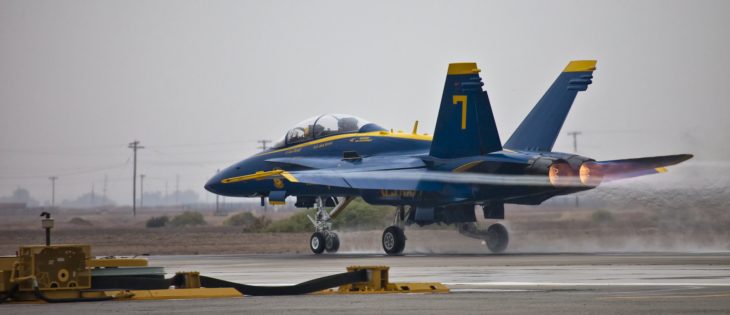
How Many Blue Angels Have Crashed?
A little over two dozen Blue Angels have crashed during training or airshow performances, resulting in the death of 27 pilots. Almost half of the crashes occurred when the pilot was flying at a low altitude, which provides less room for error when performing a risky maneuver.
Most crashes have resulted in the death of the pilot, but there have been a few crashes where the pilot managed to eject. For example, in 1987, Lead Solo Pilot Lt. Dave Anderson was forced to eject from his hornet after experiencing a dual engine flameout.
How Close Do the Blue Angels Fly Together?
According to publicity materials, the Blue Angels fly just 18 inches apart. However, one former Blue Angel claims that the planes get much closer. US Marine Major Dusty Cook believes that the tips of the wings get as close as six inches.
The Blue Angels can fly close together due to the air pressure created by each jet. The air creates a bubble of pressure around the aircraft. When the planes start to travel too close, the pilot may feel resistance from the air pressure created by the adjacent aircraft. This allows the Blue Angels to travel at extremely close distances without scraping wings.

How Many Blue Angels Teams Are There?
There is a single Blue Angels team that consists of 16 pilots and a little over 100 sailors and Marines. The team could technically be divided into two teams, the flight team and the support team. The support team includes enlisted personnel who handle maintenance and support activities, including event coordination, jet maintenance, and administrative tasks. The 16 pilots travel around the country to perform in airshows. About 45 members of the support team travel to each airshow.
What Makes the Smoke on the Blue Angels?
One of the most distinctive features of a Blue Angels airshow is the smoke that trails from the jets, which is used to make it easier for spectators to follow the flight paths. The smoke also makes it easier for solo pilots to see each other when performing opposing maneuvers.
The smoke is created by pumping a biodegradable, paraffin-based oil into the exhaust nozzles of the aircraft. When the oil hits the exhaust, it instantly vaporizes into smoke. The smoke does not pose any hazard to the environment.
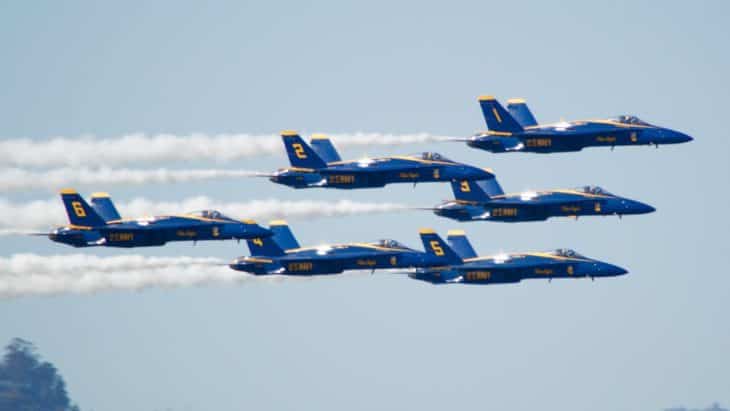
Related Posts
- Wet-Leasing and Dry-Leasing in Aviation Explained
- 10 Low Hour Pilot Jobs
- RCAF Snowbirds: Canada's Aerobatics Team
Source: https://aerocorner.com/blog/blue-angels/
0 Response to "What Does Navy Do With Retired Blue Angles Jets"
Post a Comment